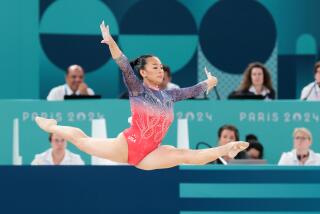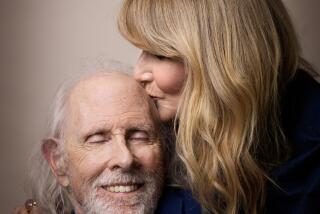Dragon Days
- Share via
HONG KONG — In a small, windowless room in Hong Kong’s Central district, a group of middle-aged men have gathered as if members of a secret society. This is something they do unfailingly every Tuesday night, wearing Bruce Lee T-shirts stretched over their generous bellies and flabby arms. And week after week, they come bearing new Bruce Lee magazines, laserdiscs and books.
They also come with fresh stories, information and pure gossip, anything that might bring them closer to the memory of, and the truth about, their hero, Bruce Lee, who died 25 years ago today.
These men are part of the 600-member, Hong Kong-based international Bruce Lee Fan Club. And tonight, they sit, leaning forward in their chairs, listening intently to Lawrence Cheng, a 35-year-old legal clerk, as he recounts a pivotal morning in 1973. The way he tells it, with so much impassioned detail, it’s as if the incident happened last week.
Exactly a quarter of a century ago Cheng, then a 10-year-old boy, was awakened by the incessant ringing of the telephone. It was his aunt calling from the other end of the city. “Lawrence,” she wailed into the phone. “Little Dragon has died.” Cheng didn’t believe it.
Little Dragon was the name by which the martial arts hero Bruce Lee was known throughout Asia. Lee, who divided his time between Los Angeles and Hong Kong, had been in the region for the last few months, filming the kung fu odyssey “Game of Death.” Cheng was not alone in thinking that the news of Lee’s death was some sort of publicity stunt sponsored by Golden Harvest, the Hong Kong studio that made his films. But he pulled on some clothes and a pair of slippers anyway and hurried down to the corner newspaper stand.
By the time Cheng reached the kiosk, a crowd had already gathered and people were desperately grabbing for newspapers. Every front page was covered with photographs of Lee. Each publication ran the same banner headline: “Little Dragon, Dead at 32.” The date was July 20, 1973. The cause of death: cerebral edema, a swelling of the brain brought on after Lee had taken too much aspirin.
“I still remember a typhoon was raging over Hong Kong,” Cheng says. “At that point, the rain was really pouring down. I ran through the streets with the paper opened in front of me. By the time I reached home, everything--my clothes, my shoes, the paper--was soaked. But I could not tell if it was the rain or my tears.”
Such melodrama is not unusual when locals recount exactly where they were and what they were doing when they learned that Bruce Lee died. For the people of Hong Kong, as well as average folk all across Asia, Lee--martial arts warrior, film star, cultural ambassador, philosopher and writer--was one of the most significant icons of the 20th century.
“Bruce Lee was not just a kung fu hero, he was a national hero,” says Law Kar, the programmer of the Hong Kong International Film Festival. “He not only had great physical skill but high virtues as well. People saw him as someone to work for the oppressed, for justice, for ideals.”
Indeed, the Hong Kong film industry had found its ultimate hero in Lee. “Here was a guy who, at 5-foot-7, was pretty short, who had lousy eyesight and who was Chinese, fighting to rise up in an almost completely white system,” says Bey Logan, the author of “Hong Kong Action Cinema.” “But Bruce Lee managed to overcome every obstacle put in front of him.”
For Cheng, now the spokesperson for the Bruce Lee fan club, as well as for many other Chinese around the globe, Lee holds a different appeal. “He changed completely the world’s perception of the Chinese people,” Cheng says.
It hardly matters that toward the end of his life Lee had suffered several public blows to his otherwise heroic image. For one thing, he had developed a serious cannabis addiction. For another, he was having an extramarital affair. (Although Lee was wed to his American college sweetheart, Linda Emery, who raised his two children, Brandon and Shannon, he died in the bed of Taiwanese actress Betty Ting Pei.)
But with his sudden death he became a kind of myth, a status that might have eluded him if he had continued to live.
And this month, it is Lee’s myth that hundreds of fans will chase as they gather in Hong Kong to commemorate his passing. Fans from Japan, Europe and the U.S. are expected to jet in for a series of events held in Lee’s honor. Today, Golden Harvest will premiere “And Now You’re Dead,” an action feature starring Lee’s daughter Shannon. Local pop star Alex To plans to debut a song he composed in homage to Lee. And the fan club is opening an exhibition of Lee memorabilia at the Hong Kong Arts Center, which can only be described as amazingly comprehensive.
The collection is made up of almost every imaginable trace of Lee’s existence--some 10,000 items that range from the expected (stamps, laserdiscs, rare books, Lee action figures, Lee-themed toys) to the fanatical (a pair of his shoes and pants, a face mask and a credit card receipt for a $12.55 shirt that has Lee’s signature, an item that Cheng bought at auction for $1,300).
Lee’s followers are also likely to gather, grieve and celebrate at the Bruce Lee Cafe, a charming and nostalgic restaurant and bar that opened in June. Here, even the bill of fare is meant to pay homage to the legendary screen idol. And although such culinary offerings as “Fish of Fury,” “Satay of the Dragon” and “Bruce Juice” do not quite capture Lee’s mythic qualities, they do, at the very least, hint at his remarkable resonance.
In fact, the testaments to Lee’s enduring power are everywhere in this small two-story cafe. The shelves teem with Lee T-shirts, ceramic figurines, coffee mugs and posters. His original nunchakus (a weapon fashioned from two wooden sticks and a chain) and his somber black kung fu suit from “Way of the Dragon” are displayed in a plexiglass shrine.
But it is the images of Lee in motion that stun. They flicker from TV monitors, commanding the attention of foreign tourists and die-hard local fans, who have already marked a well-worn pilgrim trail here, to stand around the cafe’s bar, silent and transfixed.
All of Lee’s fabled scenes play again and again: the 30-minute, meticulously choreographed pas de deux of primal blows, kicks and yelps performed by Lee and Chuck Norris in the Roman coliseum at the culmination of “Way of the Dragon.” Or the passages from “Enter the Dragon” in which Lee moves slowly, silently into a darkened hall of mirrors while his adversary Han lies in wait. In each of the cult-favorite scenes, Lee prowls the screen, his body radiating energy and anger.
“He was the most charismatic person I ever met,” says Jon Benn, an American-born restaurateur who opened the Bruce Lee Cafe. Benn, who moved to Hong Kong in 1970, has earned a minor international celebrity among Lee fans as the evil white villain “Big Boss” from “Way of the Dragon.”
A businessman, not an actor, Benn met the Hong Kong movie mogul Raymond Chow at a cocktail party shortly after he arrived from the U.S. “He came up to me and asked if I would like to be in a film with Bruce Lee,” Benn says. “At the time, I had no idea who Bruce was but I said, ‘Sure, why not?’ ”
Today, Benn regales the cafe crowds with tales of his friendship with Lee, which flourished even after the movie wrapped. “Bruce loved to show off,” says Benn, sitting below a photograph of himself locked in a no-contest arm-wrestle with the muscled actor. “On the set, he would suddenly drop down onto two fingers and do 100 push-ups.”
Lee holds a pivotal position in Hong Kong film and social history. He was born in 1940 in San Francisco (his father was a Cantonese Opera comic actor who toured internationally), but he spent most of his boyhood years in British colonial Hong Kong. At the age of 3 months, he made his film debut in “Golden Gate Girl” (although appearing as a newborn female baby, he was more of a prop than a character). By age 18, he was already commanding starring roles in local films. Notes film programmer Law Kar: “Even though Bruce Lee was just a boy in these pictures he already had the magnetic appeal of a superstar.”
Lee’s international screen debut came with his supporting role in the American television series “The Green Hornet.” As Kato, the Hornet’s crusading companion, he astonished American viewers with his kung fu prowess. Star-vehicle movies such as “Fists of Fury” parlayed Lee into an international celebrity and, in the process, placed the Hong Kong film industry on the map of world cinema.
Indeed, the Hong Kong boy had become a global phenomenon--something that Law says he witnessed firsthand. In 1973, Law was studying film in Rome when Lee’s kung fu epic “Enter the Dragon” was released. He went to see it at a local cinema in Rome. Although all the words were dubbed in Italian and he couldn’t understand much of the plot, Law could “instantly sense Bruce Lee’s physical appeal.”
“The Italians were absolutely crazy about him. The entire cinema began cheering wildly and pounding their feet whenever he started to fight.”
Lee redefined the way in which Asian men were perceived by moviegoers in the West--and indeed, by Asians themselves. For Hong Kong Chinese living under British colonial rule, he became a vital symbol of personal and cultural strength.
“My father first took me to see ‘The Big Boss’ when I was 7 years old,” Cheng says. “Afterward, I could not sleep all night. I kept thinking about Bruce and asking myself, ‘How could a Chinese man--or any man--be that fast, that strong?’ He showed the world a different image of the Chinese.”
More to Read
Sign up for Essential California
The most important California stories and recommendations in your inbox every morning.
You may occasionally receive promotional content from the Los Angeles Times.










